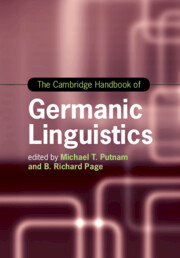Book contents
- The Cambridge Handbook of Germanic Linguistics
- Cambridge Handbooks in Language and Linguistics
- The Cambridge Handbook of Germanic Linguistics
- Copyright page
- Contents
- Figures
- Maps
- Tables
- Contributors
- Acknowledgments
- Germanic Languages
- Part I Phonology
- Part II Morphology and Agreement Systems
- Chapter 9 Verbal Inflectional Morphology in Germanic
- Chapter 10 Inflectional Morphology
- Chapter 11 Principles of Word Formation
- Chapter 12 Grammatical Gender in Modern Germanic Languages
- Chapter 13 Case in Germanic
- Chapter 14 Complementizer Agreement
- Part III Syntax
- Part IV Semantics and Pragmatics
- Part V Language Contact and Nonstandard Varieties
- Index
- References
Chapter 10 - Inflectional Morphology
Nouns
from Part II - Morphology and Agreement Systems
Published online by Cambridge University Press: 31 March 2020
- The Cambridge Handbook of Germanic Linguistics
- Cambridge Handbooks in Language and Linguistics
- The Cambridge Handbook of Germanic Linguistics
- Copyright page
- Contents
- Figures
- Maps
- Tables
- Contributors
- Acknowledgments
- Germanic Languages
- Part I Phonology
- Part II Morphology and Agreement Systems
- Chapter 9 Verbal Inflectional Morphology in Germanic
- Chapter 10 Inflectional Morphology
- Chapter 11 Principles of Word Formation
- Chapter 12 Grammatical Gender in Modern Germanic Languages
- Chapter 13 Case in Germanic
- Chapter 14 Complementizer Agreement
- Part III Syntax
- Part IV Semantics and Pragmatics
- Part V Language Contact and Nonstandard Varieties
- Index
- References
Summary
The article examines the history of noun inflection from Proto-Germanic to the modern Germanic languages which simplified the former system to different degrees. Icelandic preserved the most complex structures whereas English lost declension classes as well as gender and case. Interestingly, languages with three genders use them for the organization of their noun inflection, whereas those with two genders tend to dissociate them from declension. Most languages formalized their plural expression, i.e., morphological, phonological, or prosodic features of the stem determine the plural allomorph. The article shows that German developed a rather complex noun class system, which is based on semantics, gender, and form. Zero inflection can only be found in languages with distinct singular and plural articles. If these articles are homophonous, overt plural inflection is obligatory. These interrelations show that the noun is integrated into the NP and that its components contribute to the expression of the nominal categories.
Keywords
- Type
- Chapter
- Information
- The Cambridge Handbook of Germanic Linguistics , pp. 214 - 237Publisher: Cambridge University PressPrint publication year: 2020
References
- 1
- Cited by

